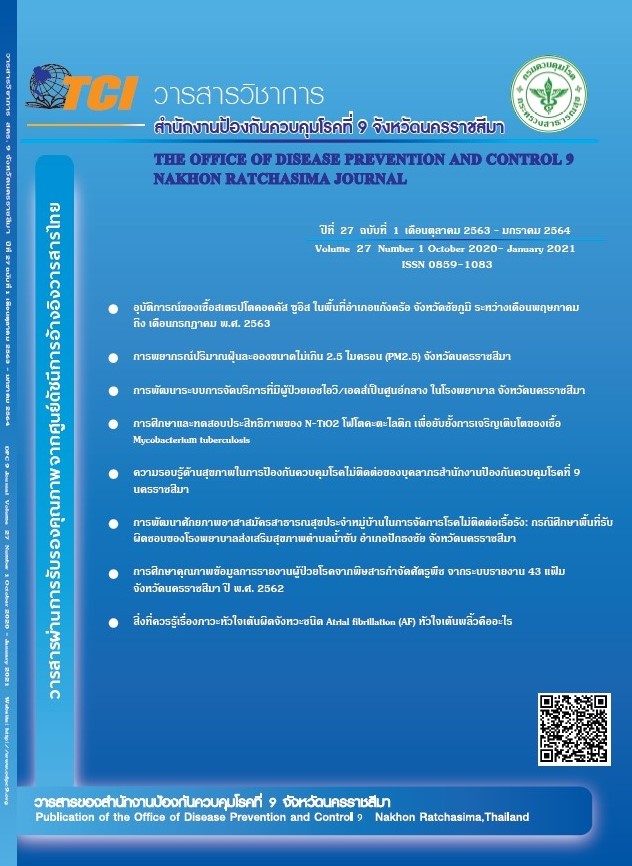Health Literacy of personnel in prevention and control of non-communicable diseases of the Office of Disease Prevention and Control 9 Nakhon Ratchasima
Keywords:
Health literacy, Prevention and Control, Non-communicable diseaseAbstract
From the health examination results of the personnel of the Office of Disease Prevention and Control 9 Nakhon Ratchasima from 2016-2018, it was found that the risk of developing NCDs increased. Especially obesity Therefore, it is necessary to conduct a health literacy survey of personnel, Office of Disease Prevention and Control 9, Nakhon Ratchasima, to study the level of health literacy of NCDs. And health behaviors 3Aor 2Sor. (Food, mood, exercise, smoking and drinking alcohol)
Research method, model of survey research Sample group The total number of 249 personnel was conducted during the study from November 2019 to August 2020. The questionnaire consisted of 3 parts, consisting of general information, health literacy, 6 components: Access to health service information Health communication Media literacy Self management and decisions and health behavior according to 3Aor 2Sor. Principles and analyzed the data with descriptive statistics. With frequency, percentage, mean, standard deviation
The research results were mostly female 59%, mean age 45 years (SD = 11.05), mean weight 65.6 kg (SD = 12.3), BMI was at normal level (between 18.5-22.9) 40.2% obese level 1 (between 23.0-24.9) 33.3% and obesity level 2 (between 25.0-29.90) 24.5% The level of health literacy according to the principle of 3Aor 2Sor found that most were in good level 39.0% ( = 74.1, SD = 13.09) when considering cognitive health. Was at a very good level, 74.7% ( = 10.9, SD = 2.14), but communication for enhancing health proficiency according to 3Aor 2Sor. was poor at 42.2% ( = 11.47, SD = 3.41) and health behaviors according to the principle of 3Aor 2Sor were found to be moderately suitable behavior 50.9%, with inappropriate behaviors including exercise 30 minutes per day, 34%, eating sweet, salty food, 49%. Drinking 2 or more alcoholic beverages per day 43.0%
Summary of recommendations, The knowledge of the personnel is at a good level. But the health behavior is just moderately appropriate. And 58% of obesity, therefore, information on the situation and knowledge of health of personnel should be used to plan the operation to enhance health literacy. And drive concrete action Personnel should modify their health behavior, diet, exercise regularly. Control the consumption of food, flour, sugar, fat and in the part of the agency. There should be a clear policy for promoting health of personnel and agencies and communicating Campaign for personnel to know and act accordingly. Correctly, suitable for their own context, the next agency
References
ป้องกันและควบคุมโรคไม่ติดต่อระดับชาติ 5 ปี (พ.ศ. 2560 - 2564), 177.
2. สำนักสื่อสารความเสี่ยงและพัฒนาพฤติกรรมสุขภาพ ผลการสำรวจความพร้อมขององค์กรต่อการ
เป็นองค์กรรอบรู้ด้านสุขภาพของบุคลากรสำนักงานป้องกันควบคุมโรคที่ 9 จังหวัด
นครราชสีมา, 2562
3. คณะกรรมการอำนวยการจัดทำแผนพัฒนาสุขภาพแห่งชาติ ฉบับที่ 12 กระทรวงสาธารณสุข.
แผนพัฒนาสุขภาพแห่งชาติ ฉบับที่ 12 (พ.ศ.2560-2564). 2559; 1.
4. World Health Organization. 2009. Health Literacy and Health Promotion. Definitions, Concepts
and Examples In the Eastern Mediterranean Region. Individual Empowerment Conference
Working Document. 7th Global Conference on Health Promotion Promoting Health and
Development. 26-30 October 2009. Nairobi, Kenya.)
5. อารีย์ แร่ทอง.2562 ความรอบรู้ด้านสุขภาพและพฤติกรรมสุขภาพ 3อ 2ส ของอาสาสมัคร
สาธารณสุขประจำหมู่บ้าน กรณีศึกษาตำบลหินตก อำเภอร่อนพิบูลย์ จังหวัดนครศรีธรรมราช
วารสารวิชาการ กรมสนับสนุนบริการสุขภาพ: 15(3). 62-70.
6. ขวัญเมือง แก้วดำเกิง. ความรอบรู้ด้านสุขภาพ เข้าถึง เข้าใจ และการนำไปใช้. พิมพ์ครั้งที่ 2
กรุงเทพฯ: อมรินทร์, 2561
7. กองสุขศึกษา กรมสนับสนุนบริการสุขภาพ. การเสริมสร้างและประเมินความรอบรู้ด้านสุขภาพและ
พฤติกรรมสุขภาพ กลุ่มเด็กและเยาวชน (อายุ 7-14 ปี) กลุ่มประชาชนที่มีอายุ 15 ปีขึ้นไป ฉบับ
ปรับปรุง ปี 2561. 2561.
8. ชาตรี แมตสี่ และศิวิไลซ์ วนรัตน์วิจิตร. การสร้างเสริมความรอบรู้ด้านสุขภาพ: จากแนวคิดสู่การ
ปฏิบัติ. วารสารวิทยาลัยพยาบาลบรมราชชนนี อุตรดิตถ์ ; 9 (2) : 2560
9. Hambleton, R.K.Principles and Selected Applicationsn of Item Response Theory.
Educational Measurement.(3th).R.L. Linn(ed). New York : John Wiley & Sons.1989.
9. ดร.กันยารัตน์ กุยสุวรรณ. แนวคิด หลักการ องค์กรรอบรู้ด้านสุขภาพ Health Literate
Organization. กองสุขศึกษา กรมสนับสนุนบริการสุขภาพ
10. พิทยา ไพบูลย์ศิริ. 2561 วารสารสมาคมเวชศาสตร์ป้องกันแห่งประเทศไทย: 8(1) : หน้า 96 – 107
11. กองสุขศึกษา กรมสนับสนุนบริการสุขภาพ. 2560 รายงานผลการดาเนินงานเสริมสร้างความรอบรู้
ด้านสุขภาพและพฤติกรรมสุขภาพของประชาชนกลุ่มเป้าหมายการดำเนินงาน ปีงบประมาณ พ.ศ.2560
12. นางวิมล โรมา กรมอนามัย. 2562 ความรอบรู้ด้านสุขภาพเป็นมิติที่สำคัญของสุขภาพในปี 2020
วันที่เข้าถึง 17 มกราคม 2563 เข้าถึงได้จาก:
http://foodsan.anamai.moph.go.th/download/D_HLO/Health%20Literacy%20&%20Health%20Co mmunication.pdf
13. คณะกรรมาธิการขับเคลื่อนการปฏิรูปประเทศด้านสาธารณสุขและสิ่งแวดล้อม สภาขับเคลื่อนการ ปฏิรูป ประเทศ. การปฏิรูปความรอบรู้และการสื่อสารสุขภาพ (ร่างแนวทางการขับเคลื่อนความ รอบรู้ด้าน สุขภาพ และการสื่อสารด้านสุขภาพ). พฤศจิกายน 2559.

Downloads
Published
How to Cite
Issue
Section
License
บทความที่ลงพิมพ์ในวารสารวิชาการสำนักงานป้องกันควบคุมโรคที่ 9 จังหวัดนครราชสีมา ถือว่าเป็น
ลิขสิทธิ์ สำนักงานป้องกันควบคุมโรคที่ 9 จังหวัดนครราชสีมา



